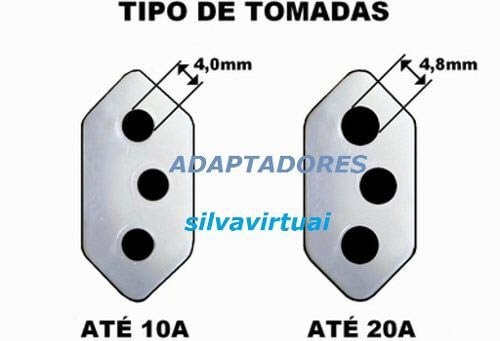 As you can see in the photo to the right, outlets are extremely confusing and it can be tough as a foreigner to figure out how to accommodate your electronics at home.
As you can see in the photo to the right, outlets are extremely confusing and it can be tough as a foreigner to figure out how to accommodate your electronics at home.
Today I am going to break down how to most effectively make sense of the outlet jungle and give you a powerful trick in order to convert your power at home to accommodate any electronics!
As you are probably already aware, electronics in Brazil are expensive and the voltage difference from city to city can be quite a nightmare.
See this post on how to figure out what voltage is available in what areas + how to deal with power surges.
Well let’s put this nightmare to rest and figure it out!
Different Outlets And Dealing With Them
Trying to understand why there are so many different outlets (“tomada” in Portuguese) and plugs in Brazil is quite a challenge.
In actuality, there are – no joke – 12 different plugs!
I will cover the main plugs and outlets that you will encounter.

What the Brazilian government is aiming for: a standardized Brazilian outlet.
You can buy a new TV and have the “standardized” Brazilian 3 pin plug

This is the plug that the government is trying to implement in Brazil in an effort to standardize everything.
It has not been very successful as there are so many imported electronics and so far has just added one more plug to the confusion…
Yeah, someday all plugs may look like that in Brazil, but until then, you will have to use a plug converter if you have an old outlet.

The old style outlets in Brazil.
Or buy a toaster and have the 2 pin European style plug

A 2 pin European plug
This is very common for areas of Brazil where the city runs off of 220v or both and is due to the fact that many appliances are imported.
If you have one of the new 2 or 3-pin Brazilian outlets, then you will have to purchase a plug converter.
Or buy a Voltage regulator and have the 3 pin American plug

The 3 pin American plug
A voltage regulator that is made in Brazil has a 3 pin American plug…
In this case, you will need a plug converter that switches it to your outlet type which can be the old Brazilian or new Brazilian style.
Or buy a digital camera and have the 2 pin American plug

2 pin American plug
A 2 pin plug is accepted by many of the old style Brazilian outlets (though not all) and if not, you can just get a plug converter for that.
Oh and there is one last plug – the high current plug for large appliances
- The plug on the right has larger holes for higher current appliances.
These go on large appliances that draw higher energy. It is the same style as the new 3 pole Brazilian plug except that the poles are thicker, it will need to be converted if you have the old outlet style
Where to purchase plug converters
Pretty much everywhere and they are very cheap. But you can definitely find them in all electronic stores, house renovation stores and large deparment stores.
They should cost you from R$.15 to R$3.00 and are worth purchasing in Brazil rather then abroad. This is due to the fact that when you buy a plug converter abroad, it will only give you the standardized Brazilian plug, which wont help you at all if the house you are staying in has the old styled one.
Accommodating Your Electronics – Even if They Are a Different Voltage
Maybe you are moving from a 110v area abroad to a 220v city in Brazil? Or maybe you are just moving from a 220v city in Brazil to another that is 110v?
Either way, there is a solution for you and I will explain it now.
Scenario 1: Your house has 110v and you need 220v
If this is the case, then your solution is actually easier then you might imagine.
All you have to do is get a reputable (emphasis on reputable!) electrician to come and convert the outlets you want to be 220v.
It’s actually a case of simple math: 110 + 110 = 220v.
Not to get all electrician in my language here or anything, but you can take two 110v lines from your breaker box and join them to create 220v.
Problem solved – just remember to label which outlets are 220v!
Scenario 2: Your house has 220v and you need 110v
My understanding is that this is a bit trickier scenario as if the power system is 220v, then you can’t just tell the power to divide in half…
The solution for this is some type of converter.
Since very few of my appliances were 110v (most were dual-volt), I found a very cheap and reliable solution: a voltage regulator with converter.
I wrote all about voltage regulators in this post, so I wont repeat myself too much. Basically you can buy a voltage regulator to protect your electronics from surges and have it convert to 110v at the same time.
These regulators usually run around R$70 reais and can handle quite a few electronics (mine has 5 outlets on the back running 110v).
If you have something big like a refridgerator you imported from the USA for example, then you will need a larger converter.
In that case, you can find the label on the back that says how much energy it needs and bring a picture of it to a local electrical shops and see if they have the appropriate converter for it.
You can then have an electrician come and install it for you.
Scenario 3: Your house has both and you need both
This is common in large cities like São Paulo and Rio de Janeiro where a flux of immigrants have come with their appliances that vary in voltage.
Usually, the large appliances will have 220v outlets and small appliances 110v. I’m not sure about the validity of this or not as I’m no electrician, but it’s said that large appliances running on 220v use less energy then on 110v.
I’m told that this is the reasoning behind this.
Final Words
Brazilian electricity can be quite a jungle and fortunately all you need is a map to navigate!
I hope that this served as a decent map to help out and make sure to like and share this if it did.
Do you have any interesting stories you can tell about Brazilian electricity?
Cheers – valeu!

